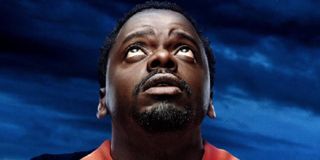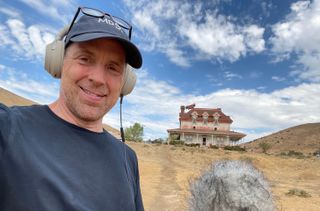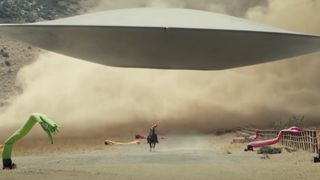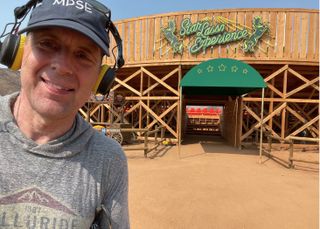
Award-winning British sound designer and re-recording mixer Johnnie Burn has an appetite for dark, compelling material when he’s searching for projects to lend his sonic talents to, and so his work on director Jordan Peele's new thriller, "Nope," was the perfect vehicle for building a multifaceted, immersive soundscape for audiences.
Burn's artistry had already been heard in 2014's "Under the Skin," the disturbing sci-fi film starring Scarlett Johansson as a homicidal alien, and 2017’s "The Killing of a Sacred Deer" with Colin Ferrell portraying a father who's forced to make an unthinkable sacrifice.
Teaming up with Peele ("Get Out," "Us") on "Nope" was a chance to truly expand his aural imaginings to new dimensions by conjuring up a fantastic range of acoustic dreams and nightmares.
Space.com spoke with Burn about manifesting credible noises for "Nope," working with Jordan Peele to expand the film’s complex universe with sound effects, presenting an authentic realization of the aerial predator nicknamed Jean Jacket, and using Dolby Atmos technology to create an enveloping "dome of sound" in theaters.
Space.com: What attracted you to this project and why did "Nope" offer you an opportunity to elevate your sonic game?
Johnnie Burn: For any sound designer or sound editor, a foray into sci-fi is something they’re going to be extremely interested in because of all that uncharted territory where you can make up the sounds as you want them because nobody has ever heard it before. Who's going to tell you you're wrong? Working with Jordan Peele was a huge attraction, but more than anything, that script is really written for sound.
There's an awful lot of you standing there with the characters and the way that it's shot and it's the sound that's helping push the narrative. So for me that was a challenge not to be missed.
Get the Space.com Newsletter
Breaking space news, the latest updates on rocket launches, skywatching events and more!

Space.com: What was it about your work on "Under the Skin" and "The Killing of a Sacred Deer" that made Peele realize you were the person for the job?
Burn: He did talk to quite a few people about the role of sound designer on "Nope." He’s just an enormous fan of "Under the Skin." For my film school, it was three decades of working with Jonathan Glazer on music videos, commercials, and his feature films. And because he’s a very hands-on director he'd edit with me every single minute of the day. Those processes over many years taught me how to appreciate what is working on sound in film and how a film goes together.
I think what Jordan was reacting to was the rigor with which the sound of "Under The Skin" was created. The sound is very realistic and it’s almost documentary sound but somehow it’s been conjured into a sort of cinematic universe. Its sound is quite narrative because there wasn't a lot of dialogue in that film.
Space.com: How did you hope to build a credible sound language for "Nope" and what did you and Jordan discuss on how best to apply it?
Burn: Right from the start we were pretty clear that this wasn’t going to be a film where we were going to enjoy making super weird alien sounds. For the first half of the film the monster in "Nope" is a predator and you'd expect it to be stealthy. So we were exploring the ideas of how it would be these disturbances in the environment that would help you realize there was something going on. The wind is changing, and there’s a rustling of leaves and that kind of thing. A stealth apex predator is not going to waste energy by making a lot of noise and moving.
But what might make a sound is the things trapped inside it. We were looking at how screams and winds have such a similar trajectory and pitch, so we started painting this blurred space between the two that would sound sort of like a wrong wind. That’s how Jordan kept describing it. "Make it sound natural, but I want it somehow innately wrong with it." And that's where the alien being side of it came from, rather than being some clever, software-driven monster sound.

Space.com: Were there any specific movies you screened that helped influence the film's soundscape?
Burn: Well, we discussed how the skinny-dipper in "Jaws" is the benchmark terrified scream and how the song world of "Nope" would rely heavily on the credibility of screams. There’s no point in having a bad-acted scream. The way I tend to approach film is a more realistic, warts-and-all type of soundscape, and Jordan had talked in a lot of detail what he loved about "Under the Skin." So I think I always knew what I was trying to do with "Nope."
We watched "Close Encounters of the Third Kind" as well and referenced films to each other like Arrival, but there was never any specific aim other than we both enjoyed when that big bassy moment comes in "Close Encounters" and a few filmic moments that we would pay homage to.
Space.com: For the Jean Jacket creature, which types of animal noises did you listen to for inspiration?
Burn: I was in a lot of Jordan's Zoom calls to fluid dynamics professor John Dabiri, who was fascinating to talk to. Specifically we looked at the avian world because flight is so economical with energy for birds and a lot of flying creatures mimic sounds. In the same way that Jean Jacket let out a burst of steam to disguise itself as a cloud, we had this other idea that there are moments in the film where retrospectively you can think maybe it’s just mimicking screams.
So when Jean Jacket is over the house it's happy to let the people down below hear screams and that’s a form of taunting terror. But in stealth mode, if Jean Jacket had a belly full of screaming humans then it might choose to blur things by letting out a whistle that’s the same pitch.
At the end, when Jean Jacket unfolds and becomes like, "Look at me, I'm attention-seeking," a lot of what you're hearing there is a peacock massively slowed down, and that seemed quite appropriate anyway. So all those bassy blast sounds are only a greatly slowed down peacock.

Space.com: Is there a particular sound sequence in "Nope" that came together especially well and played perfectly on screen?
Burn: The biggest surprise for me was at a test screening with an audience in Long Beach. In the sequence in the barn with OJ when he gets visited by the young kids disguised as aliens, originally that scene had score on it and the sound of sprinklers in the background. To more greatly immerse you in the moment, we dispense with the score and use sprinklers and the rhythm of many different sprinklers layered up sounding almost like sighs, adding edge and tension. Along with that is the sound of the kids making that pseudo-alien clicking noise.
This was about a year ago when I first developed that sound with Jordan. At the time there was this video on TikTok where someone says "SKSKSK, Save the Turtles." I was showing the sprinklers scene to my 13-year-old daughter and she said that sounds a bit like the TikTok meme. So I put a microphone in front of her and made her say "SKSKSK" again and that was it.

Space.com: How did using Dolby Atmos help enhance and illuminate "Nope's" storytelling?
Burn: It's rare to actually find a project where you can justifiably use all the dimensions of sound. Dolby Atmos is a much more expanded soundscape to many different compass points within the theater. Normally a cinema would have the three main speakers behind the screen providing the bulk of the music and sound and voice, and a couple of speakers around the rear walls giving you a pseudo three-dimensional space. What Atmos does is give you speakers all around the room and including on the ceiling. The biggest differences are that you can do height information, whereas before you could only do left, right, front, and back.
The script is written about things flying in the sky above us and so much of what we were trying to do is misdirect with sounds that come from above you. And also, the camera angles that cinematographer Hoyte van Hoytema was employing really lend themselves to using 3-D space.

Space.com: What is it about "Nope" that's so different and provocative for you and why are audiences responding positively to it?
Burn: It's definitely a love letter to the film industry. It has so much of that within the script. There's an IMAX camera filming an IMAX camera! On a more meta level, fundamentally it's about the things that people do when they make films and when they amateurishly make films about themselves. It's got a hell of a lot to unpack. It's been such an honor to get to work on a project of this magnitude.
Director Jordan Peele's "Nope" is currently in theaters.
If you're looking for more amazing sci-fi movies, check out our guide to upcoming science fiction movies for the year. You can also see our best space horror games guide to see if you can hear yourself scream in space.
Follow us on Twitter @Spacedotcom or on Facebook.
Join our Space Forums to keep talking space on the latest missions, night sky and more! And if you have a news tip, correction or comment, let us know at: community@space.com.

Jeff Spry is an award-winning screenwriter and veteran freelance journalist covering TV, movies, video games, books, and comics. His work has appeared at SYFY Wire, Inverse, Collider, Bleeding Cool and elsewhere. Jeff lives in beautiful Bend, Oregon amid the ponderosa pines, classic muscle cars, a crypt of collector horror comics, and two loyal English Setters.
